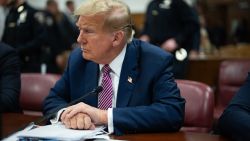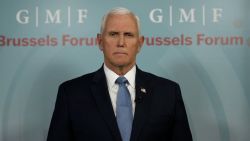Editor’s Note: This story was originally published on June 23, 2019. It has been updated to reflect Trump’s dismissal of national security adviser John Bolton and Director of National Intelligence Dan Coats.
You’re fired! You’re hired! That’s it.
It was so seamless on The Apprentice.
But that was TV. In the real world, as President, things are are much more difficult for Donald Trump, which is how the US comes to be facing the possibility of military action against Iran without a confirmed Secretary of Defense.
It’s also how the US is facing what Trump calls a national emergency at the border with Mexico without a permanent Secretary of Homeland Security.
And on the flip side, it’s why Trump is stuck with the Federal Reserve Board Chairman he nominated in 2017 but has since soured on and routinely vilifies for not cutting interest rates.
Since taking office, Trump has blown through West Wing staffers and Cabinet secretaries at a rate unprecedented in modern US politics.
He’s a mercurial boss – high on an aide or Cabinet secretary one day and ready to fire them the next, which means he’s been through multiple principals and understudies and still can’t find the right fit for key cast members.
Trump’s generals are all gone
Recall that early in Trump’s presidency he surrounded himself with former generals – James Mattis at the Pentagon, Michael Flynn and then H.R. McMaster as National Security Adviser, and John Kelly first as DHS Secretary and then as White House chief of staff.
All of them are gone now.
Flynn was dismissed for lying about Russia contacts. Kelly had his authority undermined and was then pushed out. McMaster quietly exited after not gelling with the President. Mattis resigned without a public word but in spectacular fashion, sending a letter describing his differences with the President.

In the place of generals, and despite his pledges to drain the swamp, Trump has sought out former defense contractors. Secretary of State Mike Pompeo, before running for Congress, ran an aerospace company. Outgoing acting Defense Secretary Patrick Shanahan spent a career at Boeing. New Defense nominee and current Secretary of the Army Mark Esper worked at Raytheon.
Coincidentally or not, Trump is ramping up to use the military as a blunt force instrument against Iran; he was “cocked and loaded” Thursday before changing his mind about a strike to make Tehran pay for a downed US drone.
Many, many vacant or ‘acting’ positions
Trump is working through Cabinet secretaries (acting and confirmed) at a remarkable clip, but he likes to take his time with formal nominations.
He let Shanahan serve as acting Pentagon chief for more than five full months before nominating him in May. Shanahan pulled his name from the confirmation process when the Washington Post published a story about his difficult divorce and domestic incidents between his ex-wife and troubled son.
He waited a month from the time Sessions resigned to formally nominate his replacement William Barr while testing the lines of succession at the Justice Department by installing Matthew Whitaker as acting attorney general rather than Deputy Attorney General Rod Rosenstein.
There’s been a temporary acting Secretary of Homeland Security, Kevin McAleenan, running the Department of Homeland Security for months since the departure of Kirstjen Nielsen in April. Despite a border crisis for which he declared a national emergency, he has yet to nominate a successor.
Nearly 40% of Senate-confirmable positions are not permanently filled, according to the Partnership for Public Service, a nonprofit that tracks these things. More than 50% of such positions are not filled at the Justice Department. Of the 24 top-level roles listed at the DHS website, 12 are either acting or vacant.
The situation at DHS is perhaps the most concerning, given Trump’s efforts to end-run Congress to build his border wall and the controversial detention of children and families who are caught entering the US.
Trump did recently nominate Ken Cuccinelli, a divisive conservative voice and Virginia politician, as acting head of US Citizenship and Immigration Services.
The laws governing succession at the Pentagon are different, but Esper will have to resign as Army secretary before he can be nominated as Defense Secretary, thanks to the Federal Vacancies Reform Act of 1998.
That act stipulates that an acting secretary like Esper can only serve for 210 days, but there are exceptions. The clock stops when a person is nominated – but that person can’t stay on as the acting secretary.
The act, passed by a Republican-controlled Congress during the Clinton administration, stipulates that only a principal deputy to a position can serve in an acting capacity for a position to which she or he has been nominated, according to a very thorough examination of the law by the Congressional Research Service.
A difficult boss
Many see Trump’s embrace of temporary staffers in top Cabinet roles as an effort to subvert the Senate’s Constitutional role of “advice and consent” in who runs government agencies. And there’s probably something to that; he’s loathe to let his secretaries testify before Congress.
But Trump has also embraced it for roles that don’t require Senate confirmation. Acting White House chief of staff Mick Mulvaney has been acting in that role since December of 2018.
“Acting gives you much greater flexibility. A lot easier to do things. So that’s the way it is,” Trump said when asked about the situation.
Part of it may be the same reason Trump no longer has a communications director or that his press secretary (still Sarah Sanders, who is resigning at the end of the month) hasn’t given a press briefing in more than 100 days. And why he hasn’t made any move to replace former Fox News executive Bill Shine as communications director, a role most infamously held by financier Anthony Scaramucci for just ten days.
Trump sees himself as defense secretary, homeland security secretary, press secretary and communications director. For a man who made his living putting his own name on buildings, there is only room for his own opinion.
And that’s probably why he’s so galled by Jerome Powell, the Fed chairman who has yet to cut interest rates as Trump has demanded.
But there’s little Trump can do. The law makes clear that the Fed chairman serves in that role for four years. Powell assumed the role in early 2018.
Speaking to reporters Tuesday, Trump wouldn’t rule out demoting Powell, an unprecedented level of meddling with a position that’s supposed to be shielded from it.
All of this reinforces how difficult it must be to work in close proximity to Trump. You could check in on Twitter to learn that you’re fired or, he might publicly disagree with you during an interview, as he did recently for FBI Director Christopher Wray.
“The FBI director is wrong,” Trump said, agitated when George Stephanopoulos pointed out Christopher Wray said politicians should tell the FBI if they’re contacted by a foreign government wanting to interfere with the a US election.
Try negotiating a trade deal on his behalf. US Trade Rep. Robert Lighthizer has been contradicted by his boss in an Oval Office meeting.
Or he might kick you out of a room for coughing, as he recently did for Mulvaney. But if he fires you, he might not hire a replacement.
When he took office, Trump promised to surround himself by the very best people. But he’s running out of them. And despite his repeated claim that plenty of people want to work in his administration, it has a lot of empty spaces.



















